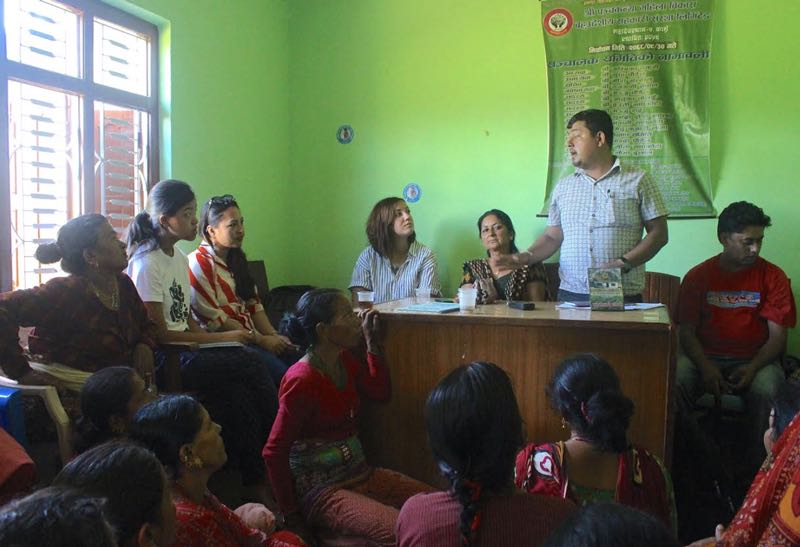NEWS
October 19, 2016

IN BRIEF
By: Narayan Adhikari, who runs the Accountability Lab in Nepal, and Pranav Budhathoki, Executive Director of Local Interventions Group. This blog post was originally published by Feedback Labs. In February 2016, almost a year after Nepal’s first devastating earthquake, government officials and 344 earthquake-affected Nepalis squatted on the grounds of a public school in the epicenter district of Gorkha. This was a community meeting organized by Accountability Lab and Local Interventions Group. The group collectively set out to solve a serious problem– there was not enough assistance to survive. The government showed no sense of urgency to speed up aid delivery. Citizens demanded […]
SHARE
By: Narayan Adhikari, who runs the Accountability Lab in Nepal, and Pranav Budhathoki, Executive Director of Local Interventions Group. This blog post was originally published by Feedback Labs.

In February 2016, almost a year after Nepal’s first devastating earthquake, government officials and 344 earthquake-affected Nepalis squatted on the grounds of a public school in the epicenter district of Gorkha. This was a community meeting organized by Accountability Lab and Local Interventions Group.
The group collectively set out to solve a serious problem– there was not enough assistance to survive. The government showed no sense of urgency to speed up aid delivery. Citizens demanded answers of the local officials, who they blamed for the delays and denials. Rumors and speculation swirled about where the relief was going and why.
So, within our larger earthquake work – the Citizen Helpdesks supported by GlobalGiving – we created a focused experiment to understand, and address, these negative feedback loops. To test the feedback loop we picked two different, severely affected communities in Gorkha: Bungkot and the more remote Namjung. To do so, we built from an existing OpenMic project with Internews that was collecting rumors in the districts.
We anticipated that these rumors would illuminate misunderstandings about how to access basic relief and a lack of proper communication channels between citizens and relief providers, and we could then debunk them with validated information from the government and donors, put out through bulletins.
In Bungkot, we supplemented our OpenMic rumor tracking bulletins with conversations with government officials on local FM radio shows, using information gathered from weekly community meetings. Communities in Bungkot were also given access to a SMS short-code to report grievances through text messages for free.
Resources precluded us from running a similar experiment in Namjung, so we used this community as the “control,” or non-intervention group. We recruited local journalists skilled at gathering information to serve as “frontline associates”, listening to citizens on the ground in order to keep a tab on the number of rumors that originated in Namjung, without instituting any methods to close the feedback loops, such as issuing bulletins, using local radio to communicate information, conducting community meetings, or reporting through SMS.
We compared both communities to understand feedback loops after humanitarian disasters.

80% of the Bungkot residents responded positively when asked “Are you satisfied with what the government is doing for you after the earthquake?” in line with the Gorkha district average of 85%. And a whopping 90% of citizens responded positively when asked, “Do you have the information you need to get relief and support?” – in line with the Gorkha district average of 92%.
In sharp contrast, only 28% of citizens as part of the control group in Namjung responded positively to the first question on government responsiveness, compared to Gorkha district average of 85%). Similarly, only 51% of citizens responded positively when asked about the information they needed, compared to Gorkha district average of 92%. As the President of a Gorkha district chapter of the National Federation of Journalists, Bhim Lal, told us:
Local officials wanted the Open Mic program across the district as they saw this feedback loop as a great supplement to their work.
We are now creating a rumor tracking handbook in which we will outline some of the larger lessons from this work, but for now, it is worth considering three key take-aways:
- Process matters. Duh – but these findings are not the result of an effective feedback loop as much as an effective process in creating the feedback loop. The real catalyst for closing feedback loops is the mixture of processes – 1) whether communities have been informed sufficiently; 2) whether trust has been built consistently over time through repeated interactions with communities, even before a disaster; and 3) whether all available platforms (SMS, radio, community meetings and so on) have been cheaply and efficiently deployed.
- Actually, it’s not all about citizens. Communities should be at the heart of feedback loops, but so should government officials if those loops are to be closed efficiently. Our process worked in Bungkot because we made sure that the government was involved in every step: design (through brainstorming with our Citizen Helpdesk teams); collection of information from citizens (through coordination with our helpdesk volunteers); analysis (through joint assessments of data); dialogue (through community meetings and radio shows); and course correction (through work to coordinate and collaborate with central line agencies and donors to fill gaps).
- Closing emergency feedback loops can generate sustainability. Before the earthquake, a systematic process of this sort for gathering and tracking information didn’t exist in these two districts. In Bungkot, now a year and a half afterwards and without our continued support, community meetings around relief issues are still taking place, local radio stations still gather rumors to dispel with verified information and local government officials are still working collaboratively to fix problems. In Namjung, the opposite is the case—we visited recently and found very little effort to provide information to citizens and a high level of dissatisfaction with government.
All of this goes to show that feedback loops matter – in real, tangible ways that affect citizens’ lives. We ignore them at our peril.
Help us explore this topic further at our upcoming Labstorm during the Feedback Summit in Washington DC next week!
